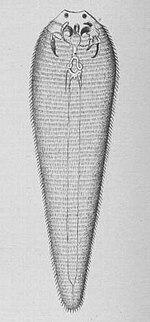Description
The adult parasite is dorsoventrally flattened, tapering backwards, resembling a vertebrate tongue thus, inspiring the common name of "tongueworm".
Physical characteristics; males: 18–20 millimetres (0.71–0.79 in) in length, while the females are 80–120 mm (3.1–4.7 in).
Disease
Linguatulosis is a condition associated with the organism Linguatula serrata. More generally, linguatulosis can be considered a form of "pentastomiasis", which refers to all diseases caused by pentastomids, including porocephaliasis. [1]
This disease is often accidentally identified during autopsy because of its asymptomatic effect on the body.
Epidemiology
Among Linguatula serrata infecting Cairo street dogs, 10% were juveniles, 59% were males, and 31% were females, corresponding to a sex ratio of 1.9:1. Of all infections, 67% were found during spring and summer, compared to 33% during fall and winter. The probable source of canine infections is infected lymph nodes of cattle, sheep, goats, and/or camels, which produce the symptoms of halzoun and the marrara syndrome in man when consumed raw. [2]
This page is based on this
Wikipedia article Text is available under the
CC BY-SA 4.0 license; additional terms may apply.
Images, videos and audio are available under their respective licenses.

